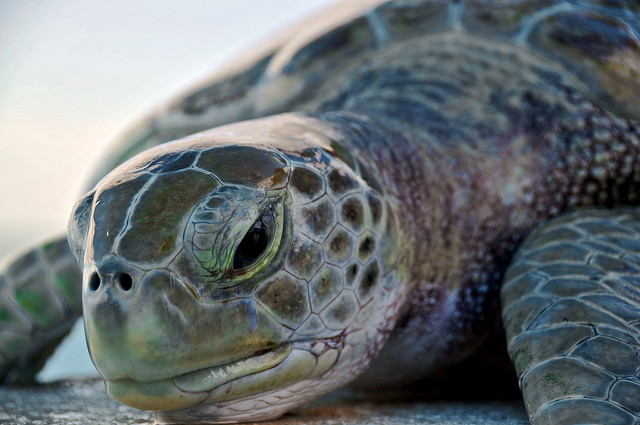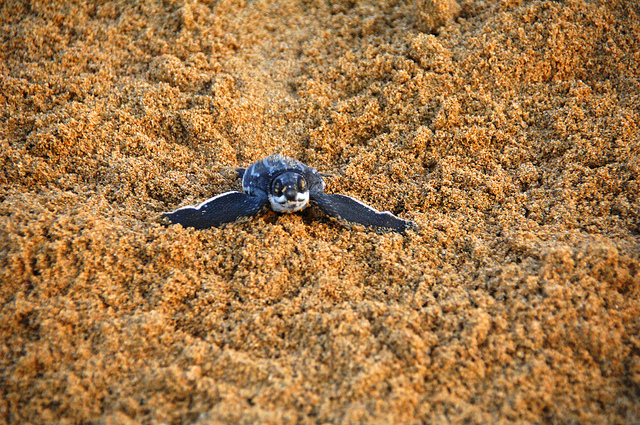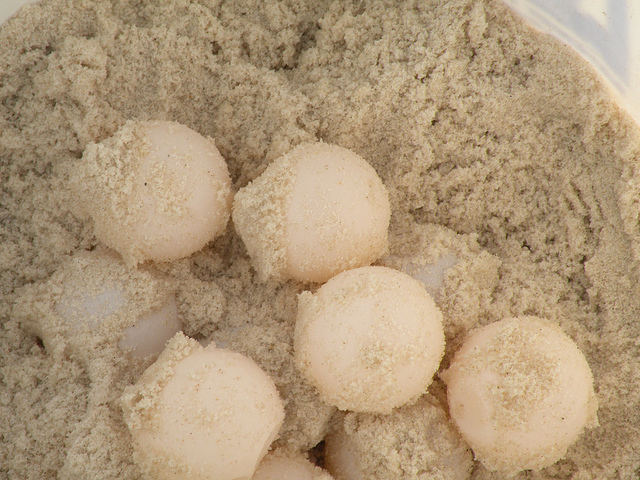
photo by Ben Alman
The egg laying of sea turtles is the most mystical scene of the nature you should witness at least once in a lifetime. There are a few beaches in Japan where sea turtles come ashore for nesting. Most of those beaches are located in remote areas with inconvenient transport connections from metropolitan area, however, all your efforts will be rewarded once you see it. This column will introduce major sea turtle nesting beaches in Japan.
The basics about sea turtles

photo by Angel Xavier Viera-Vargas
Among all turtles and tortoises that are part of the order Testudines, sea-dwelling families are called the sea turtles. Sea turtles have flippers instead of feet. Unlike their terrestrials and fresh-water counterparts, sea turtles are unable to retract their flippers into their shells. As can be seen in the old tale “Urashima Taro”, which a sea turtle is described as a guide to take Urashima to the underwater palace “Ryugu”, sea turtles have been familiarized creatures in Japanese culture. Among the five species of sea turtles dwelling in the sea around Japan, the three species, the green, loggerhead and hawksbill have recorded cases of nesting on shores within Japan. In particular, the loggerhead sea turtles which dwell in the North Pacific Ocean require the highest protection by Japan, since their nesting sites are confined to the Pacific side of the Japanese archipelago.
About egg-laying of sea turtles

photo by Deepwater Horizon Response
The breeding season of sea turtles is generally starts May and ends in August, and female turtles come ashore only for egg-laying at night. They bury themselves lightly in the sand and dig a circular hole about 60cm deep by using their hind flippers, then spend 1-3 hours to lay about 100 of ping pong ball sized eggs. After laying, they re-fill the nest with sand and return to the ocean. In regard to a common belief that a female sea turtle cries when she lays eggs, what she discharges is not tears but highly saline mucus. Sea turtles have glands within their body to discharge salt built up through feeding and dwelling under seawater. A gland is located in each eye to discharge mucus from their eyes, therefore it looks as if female turtles are crying. This is merely a common physiological response of body salinity control, but it is often interpreted as something sacred because it happens associated with the beginning of new lives, and looks as if it resulted from the affection of a mother for her babies.
Do’s and Don’ts when watching sea turtle nesting
No bright lights on the shore
Bright lights intimidate female sea turtles and prevent them from landing or laying eggs. Also, hatchlings lose their sense of direction to the ocean by bright light. Cope with a temptation to take photos with flash and just stay still and observe the shore.
Keep the sea shore clean
It is more than likely that obstacles on the shore disrupt hatchlings heading to the ocean. Don’t dispose wastes, empty cans or bottles on the shore. Also, alcohol drinks and smoking are prohibited as well when watching sea turtle nesting.
Keep quiet on the sea shore
Sea dwelling turtles have a keen sense of hearing and even gentle human voice or footsteps can disturb them. Keep quiet as possible while you wait for nesting sea turtles. Playing bright and noisy sparkles is clearly out of the question.
Don’t approach nesting sea turtles
Female sea turtles become very sensitive before egg-laying. They might return to the ocean without laying eggs once they detect human presence. Just watch them landing and digging a hole from distance, then approach from behind once they commence laying. Make sure you spare an adequate distance from her.
Don’t touch or take sea turtles and their eggs
Sea turtles are highly protected all over the world as species in danger of disappearing. Never touch or take sea turtles and their eggs to protect the species.
1. Senrinohama, Minabecho Wakayama prefecture
Known as the best beach for nesting of the loggerhead sea turtles, this 1.3km long beautiful beach accommodate nesting female sea turtles almost every night from May to early August. All spectators are required to apply for permission from the Minabecho board of education to view egg-laying sea turtles beforehand. The procedures are simple, after sending your address, name, contact number, preferred date, number of participants and purpose of observation via email or fax, you will receive the instructions from the board of education. Follow the instructions of the member of researchers group or observer on the site.
Senrinohama (Manbe Town Tourist Information Center)
Address: Yamauchi, Minabe-cho, Hidaka-gun, Wakayama
10min by car from JR Nanbu Station
2. Ohama beach, Minamicho Tokushima
Located in Minamicho (former Hiwasacho) of Tokushima prefecture, gently slanting the Ohama beach stretch 500m toward the ocean, and is widely known as nesting beach of the loggerhead sea turtles. At Hiwasa Sea Turtle Museum Caretta locating nearby the beach, variety of displays are available for people who missed sea turtles nesting on the beach. Visitors can enjoy viewing cute little sea turtles in the water, observing a sea turtle’s belly from right below, or watching huge turtles over 1m of size swimming in the large pool. The neighboring inn “Umigamesou” offers a reasonable pricing in addition to an announcement service when sea turtles are landing.
Ohama beach (Minamicho Website)
Address: Hiwasaura, Minamicho Kaifugun Tokushima
5min by car from JR Hiwasa Station
3. Nagata Inakahama (Yakushima, Kagoshima)
Kagoshima prefecture is known for the largest volume of sea turtles nesting. Among other beaches, the Nagata beach is famous as the best nesting beach of the loggerhead sea turtles, having over 10,000 sea turtles coming ashore for nesting within a season. Spectators are required to join the local observation group to book a viewing session. Each session costs JPY1,500 per adult, and junior high school students and under are free of charge. After having 30minites information session, members commence observation following the instructions from an attendant. Book early via Nagata Sea Turtle Liaison Council website as only limited number of seats are available. Also, neighboring the Yakushima Umigame-kan displays educational materials including photo panels with captions in English and Japanese for foreign tourists.
Nagata Inakahama (Yakushima Tourism Association)
Ngata Yakushimacho, Kumagegun Kagoshima
Flight from Kagoshima airport to Yakushima airport, or high-speed boat
4. Ogasawara (Ogasawaramura, Tokyo)
Isolated in the middle of ocean with no airport, 26 hours journey on a boat is only access to the Ogasawara Islands. A group of the beautiful world natural heritage islands are located 1,000km south east of Tokyo city, and are known as the best nesting beach of the green sea turtles in Japan. There are about 40 beaches sea turtles come ashore for nesting. The best way to view nesting sea turtles is to join the night tour which is introduced on the Ogasawara Village Tourist Association website. Also, there is a chance to view the Bonin fruit bat which is appointed as a natural monument. At the Ogasawara marine center located in Chichijima, tourists can view the green sea turtles in the pool and learn about sea turtles, or touch sea turtles’ eggs depending on the course they choose.
Chichijima, Ogasawaramura Tokyo (Ogasawara Village Tourist Association)
25h 30min by regular liner Ogasawaramaru from Takeshiba terminal of Tokyo port
Saw the whole thing, dude
The lifecycle of sea turtles is still veiled in mystery and there is a high demand of careful protection for the species. Considerate manners are required from spectators when attending the mystical moments of egg-laying of sea turtles. Needless to say, whether or not you can encounter nesting sea turtles is completely determined by chance as they are wild animals. In such a case, stay optimistic and keep trying another chances.
